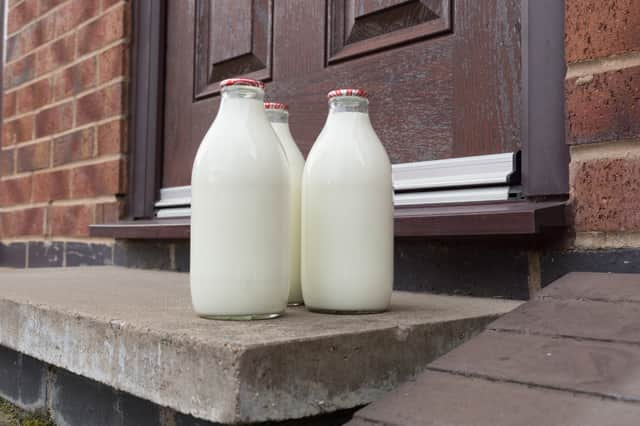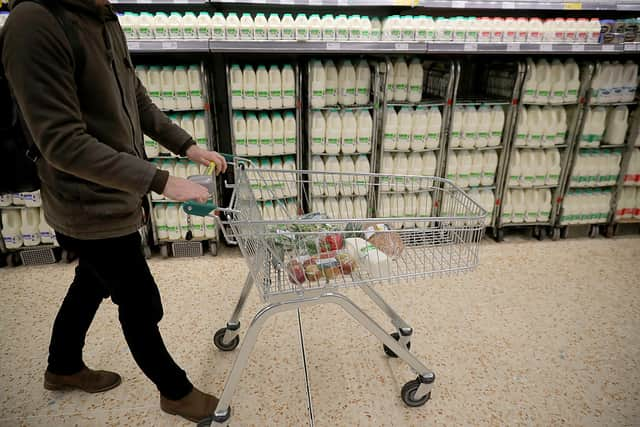Milk price increase 2022: why could prices go up by 50% in UK supermarkets amid cost of living crisis?
This article contains affiliate links. We may earn a small commission on items purchased through this article, but that does not affect our editorial judgement.


The price of a pint of milk used to be seen as one of the key barometers of how in or out of touch a politician was.
While the classic ‘gotcha’ question has almost entirely disappeared from political interviews - barring a recent nightmare grilling on Sky News for Tory minister Paul Scully - milk (or milk alternatives like oat and soy) remains a staple in most UK shopping baskets.
Advertisement
Hide AdAdvertisement
Hide AdAccording to the Department for Environment, Food and Rural Affairs (DEFRA), Brits consumed more than 11 billion pints of it in 2020.
However, despite the cost of living crisis, the price of milk looks set to rocket in the coming weeks and months.
So how much could it go up by - and what has caused this situation?
Here’s what you need to know.


Why could there be a milk price increase?
Essentially, milk prices are likely to go up because the cost of production has risen.
But there is a wider context to be aware of.
Advertisement
Hide AdAdvertisement
Hide AdMilk producers and processors have faced a profitability squeeze for more than a decade.
According to Ash Amirahmadi, the boss of major dairy processor Arla - a cooperative that’s the UK’s largest supplier of fresh milk - the price of milk has fallen 7% over the last decade despite consumer prices as a whole going up by 26%.
Indeed, Agriculture and Horticulture Development Board (AHDB) analysis has shown the price of a pint of milk rose just 4.4p (16%) to an average of 28.3p in supermarkets between 1995 and 2021.
This is despite the Bank of England showing inflation has gone up nearly 49% over this period.


Advertisement
Hide AdAdvertisement
Hide AdSo, the UK consumer has arguably been paying less than they should be for milk.
This situation has left dairy producers in a financially weak position - a position that was temporarily worsened by the Covid pandemic.
The closure of offices and hospitality crashed the price of milk to well below what it cost to make, according to the National Farmers Union (NFU), forcing some farmers to pour their produce away.
And ever since last summer, farmers have also been contending with the rising cost of production.
Advertisement
Hide AdAdvertisement
Hide Ad“We saw the inflation on farms, on feed, fertiliser and fuel, starting around June or July last year,” Mr Amirahmadi told the PA news agency in March 2022.
“There were already some pressures building, but since the Ukraine crisis that’s just increased exponentially, particularly things like fertiliser.”
The NFU says the price of nitrogen fertiliser now sits five times higher than it did 12 months ago.
The price of fertiliser is closely linked to that of gas given it is an energy intensive process, so it has risen in cost in a similar way to household bills since 2021.
Advertisement
Hide AdAdvertisement
Hide AdMany of the raw materials required to produce it, for example potash, come from Russia, meaning it is particularly exposed to the Russia-Ukraine war.
The same is also true of fuel - given Russia is one of the world’s largest oil producers - and feed - given that both Russia and Ukraine are key global suppliers of wheat and maize.
AHDB says the price of red diesel - the type of fuel used in tractors - had risen 38% year-on-year as of February 2022, while feed wheat had gone up 60% in price compared to 2021 as of March 2022.
These production cost pressures have already seen rises in the price paid by some supermarkets for milk - although, this does not guarantee prices will increase for shoppers.
How much could milk prices rise by?
Advertisement
Hide AdAdvertisement
Hide AdMr Amirahmadi said the rising costs of milk production meant his cooperative Arla was “calling time on cheap milk” when he launched its five-year strategy on 25 March.
He did not give an estimation for how much prices could increase by, but did say he felt rises would trickle through over the next five years.
UK dairy advisory firm Kite Consulting has put a figure on what price rises could look like.
It says the cost of a four-pint bottle of milk could rise from an average of £1.15 to between £1.60 and £1.70 - a near 50% increase.
However, it has not put a time frame on when this could happen by.
Average shelf-prices across the UK’s major retailers currently sit at £1.25.
Comment Guidelines
National World encourages reader discussion on our stories. User feedback, insights and back-and-forth exchanges add a rich layer of context to reporting. Please review our Community Guidelines before commenting.
